Merida’s new One-Forty range spans alloy and carbon, with the 700-level bike being the top alloy model.
The One-Forty shares the same frame as the longer-travel One-Sixty range, but features a shorter stroke shock and shorter-travel fork to create a more trail-friendly package.
Merida has built a new suspension platform for these bikes, dubbed ‘FAST', which uses flex stays, even on the alloy models, to reduce the number of pivots in the bike. Here, 143mm of travel is provided, and it’s paired with 150mm forks.
The other highlight comes from Merida's AGILOMETER sizing, whereby short seat tubes and head tubes enable a broader range of rider heights to jump on the bikes. As such, riders who like longer, or shorter bikes, should be able to find a size that fits.
Finishing off an intriguing package of developments is Merida's own dropper post. It's user-adjustable to offer anywhere from 30mm to 230mm of drop – tying in with the versatile sizing provided.
This is all well and good on paper, but it’s the on-trail performance that defines how good the best mountain bikes are, and Merida has done enough to land our Trail Bike of the Year title for 2023.
Progressive geometry, sensible kit picks and suspension that marries efficiency, comfort and grip, all contribute to a bike that should be towards the top of your shortlist.
Merida One-Forty 700 frame and suspension

Merida’s ‘ProLite 66’ double-butted aluminium is used for both front and rear triangles. The tube shapes are manipulated via a hydroforming process to create their shapes and elongated weld areas.
Cables are ported through the headset’s top bearings, into guided runs in the frame.
The rear brake hose and rear gear cable are routed through a hole in the main pivot. This means that as the suspension compresses there’s less pull on the hoses. This should reduce wear, aid suspension sensitivity and reduce the chance of ‘ghost shifting’, whereby gears skip as the suspension pulls on the gear outer.

The rear suspension has 143mm of travel, provided by a flex-stay system. The rear triangle has flex engineered into it, mimicking the action of a rear pivot. This reduces weight and maintenance requirements, while aiding rear-end stiffness.
Up-top, the seatstays push on an aluminium rocker to drive the shock.
The suspension is designed to be pedalling-friendly, but without being harsh or skippy. Longer bikes get a more progressive kinematic, matching the needs of heavier or more aggressive riders.
There’s the ability to run the bike as a mullet setup, via a flip chip at the seatstay/rocker pivot. Bikes come as 29ers, but if you go mullet you get 151mm of travel and the geometry of the bike is maintained.
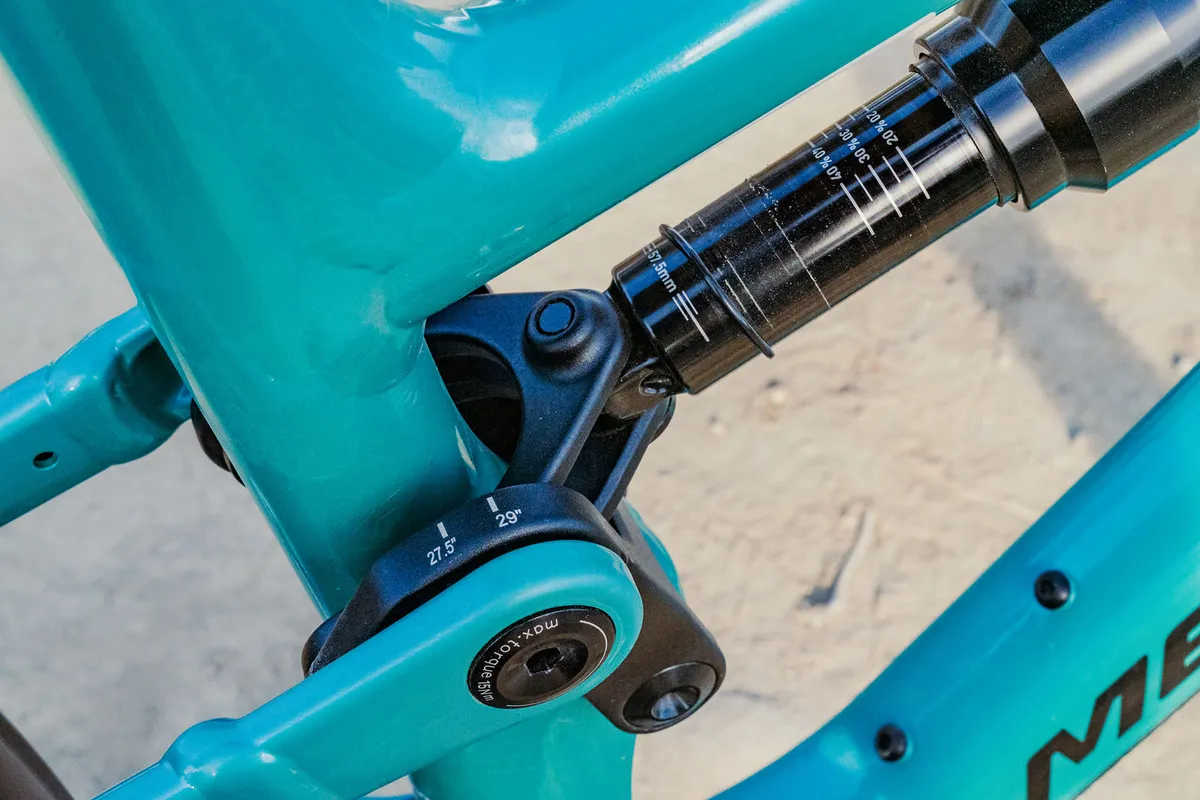
The frame features down tube and chainstay protection, while there’s a Fidlock bottle mount integrated neatly into the down tube (a bottle is also provided).
There’s a short rear fender attached to the bike, there to help protect your bearings. A longer fender will be available aftermarket, which should keep more muck off you, too. They attach via dedicated mounting holes on the frame.
Merida provides a full rundown of the bike’s hardwear items, including part numbers and torque specs, should you need to refresh linkages and pivots, easily found on its website.
Merida One-Forty 700 geometry
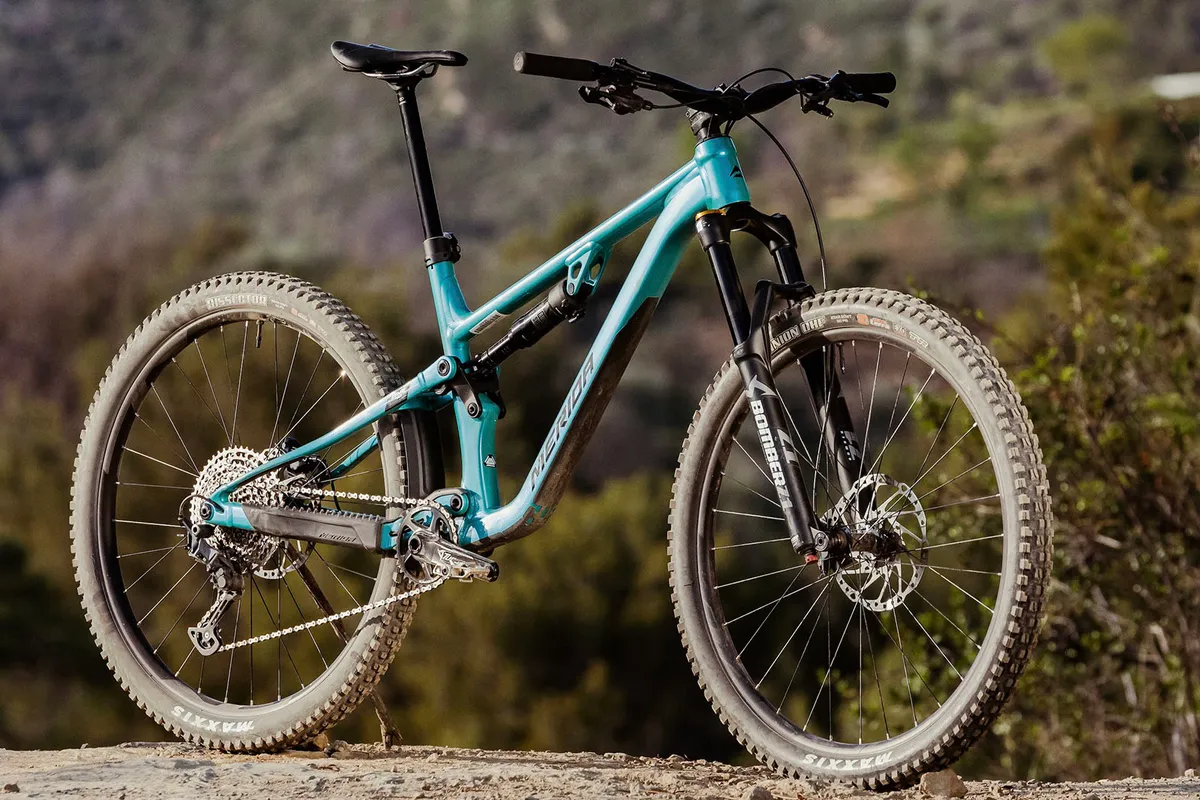
Merida has bought its trail bike right up to date when it comes to its geometry, with a long, low and slack shape that should suit aggressive riders.
The seat tube is one of the steepest out there, coming in at 80.5 degrees (at my 750mm pedalling saddle height), designed to put your hips right over the cranks.
The head angle isn’t the slackest, but is in no way steep, at 65 degrees.
The AGILOMETER geometry results in short head tubes and seat tubes, so shorter riders can still ride a bike with a longer reach.
Reaches are very long, too, for a given size. If you don’t like a longer reach, a smaller frame size should still work. Bikes will ship with long fork steerer tubes to help you get the right bar height, and the stock dropper post has up to 230mm travel.
Sizing is labelled as X Short, to X Long through five sizes.
| | XShort | Short | Mid | Long | XLong |
|---|---|---|---|---|---|
| Seat angle (degrees) | 80 | 80 | 80 | 80 | 80 |
| Head angle (degrees) | 65 | 65 | 65 | 65 | 65 |
| Chainstay (mm) | 437.5 | 437.5 | 437.5 | 437.5 | 437.5 |
| Seat tube (mm) | 400 | 410 | 425 | 445 | 470 |
| Top tube (mm) | 532 | 559 | 586 | 618 | 649 |
| Head tube (mm) | 95 | 95 | 95 | 105 | 120 |
| Bottom bracket drop (mm) | 35 | 35 | 35 | 35 | 35 |
| Wheelbase (mm) | 1,177 | 1,204 | 1,232 | 1,265 | 1,298 |
| Standover (mm) | 730 | 735 | 738 | 735 | 730 |
| Stack (mm) | 607 | 607 | 607 | 616 | 629 |
| Reach (mm) | 426 | 453 | 480 | 509 | 535 |
Merida One-Forty 700 specifications

Merida has done a good job of speccing the bike, with a series of well thought-out bits of kit, rather than anything overly flashy at the cost of other areas.
Marzocchi provides its dependable Z1 fork, with 150mm travel and a RAIL damper that’s based upon sibling brand Fox’s GRIP damper.
The drivetrain and brakes come from Shimano, with SLX featuring heavily. I’m impressed to see an XT shifter specced, though – the dual-release feature on the upshift is a noticeable performance upgrade over the SLX unit.
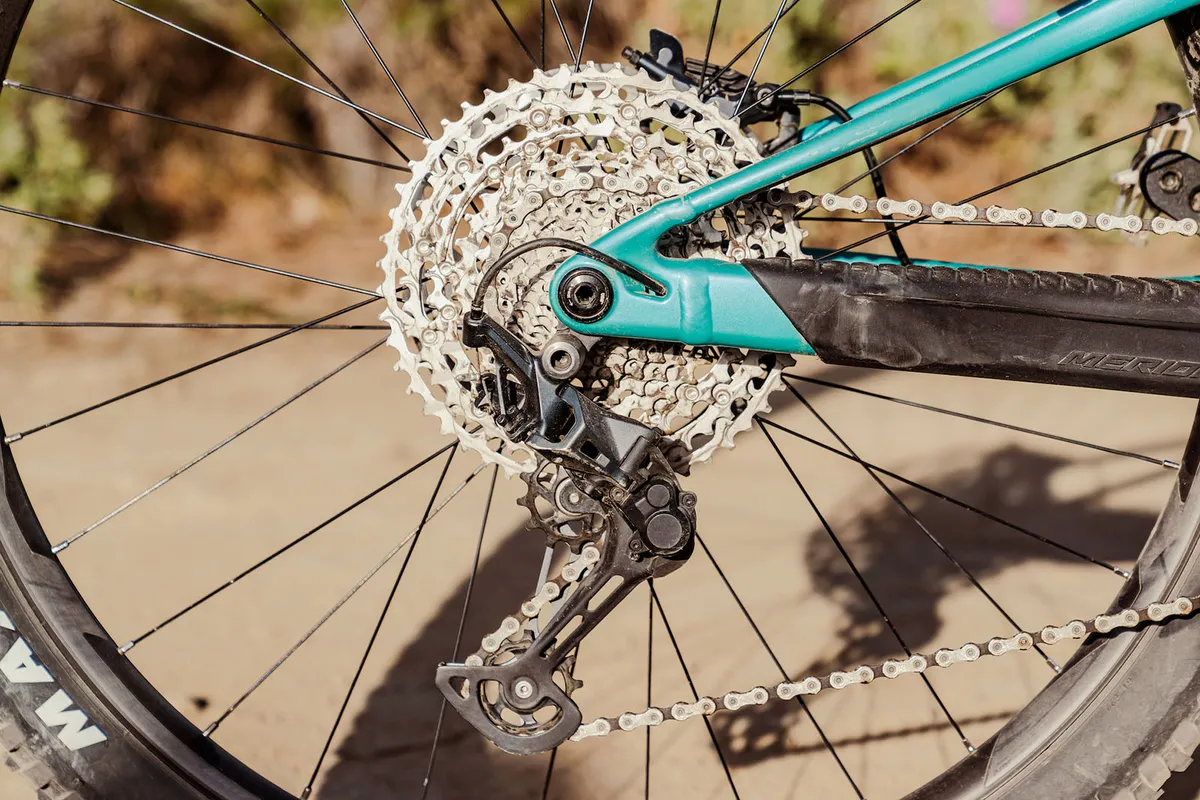
Tyres come from Maxxis, with an all-round performer Minion DHF up-front and a faster-rolling Dissector at the rear. The latter has an EXO+ casing, thicker and better damped than the EXO casing front tyre. It's handy to help guard against rear punctures.
Merida’s own rims have a 29mm internal width – nice and broad. They’re built around Shimano SLX hubs, which have a quick pick-up.
The own-brand cockpit is fine, though bars wider than 780mm would be nice to see, and I’d rather a 40mm stem than the 50mm version provided.
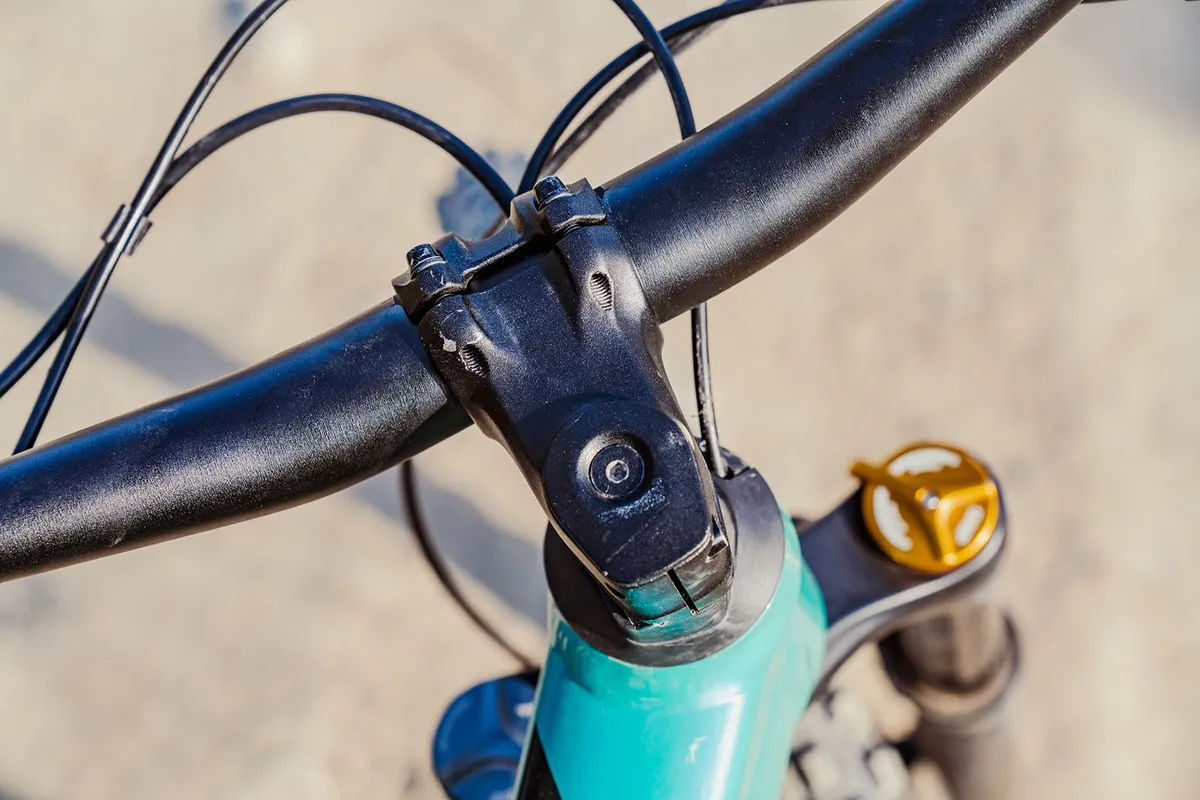
Merida's own dropper post is unique. It offers user-adjustable travel from 30-230mm. The process isn’t as slick as that found on Canyon’s dropper posts, but travel is infinitely adjustable, and the range of adjustment is vast.
A multi-tool is held under the saddle, but being right in the firing line of the rear wheel means it rusts and gets gritty pretty quickly.
The rear axle has a removable lever with an integrated stepped 4 and 6mm Allen key head. Over time, I found this started rattling.
Merida One-Forty 700 ride impressions
Merida One-Forty 700 climbing performance

Uphill, the One-Forty 700 stands out as a class leader.
Merida has managed to make the bike pedal so well that I found myself often checking the Deluxe’s lockout lever to see whether the shock was open or closed. Under normal pedalling loads, there’s no movement.
Under moderate pedalling loads, there’s still no noticeable movement. Stand up on the pedals and there’s barely any either.
Basically, you have to pedal in an incredibly ineffective manner to get the rear shock to start stealing some of your power. Under any typical situation, it’s likely you’re getting as direct a drive to the rear wheel as on any full-suspension bike out there.
This makes long drags easier, and steep pitches more efficient. The super-steep seat angle works well here, and with the suspension not wallowing deeper into its mid-stroke as your weight pivots rearward, the seated geometry of the bike remains static.
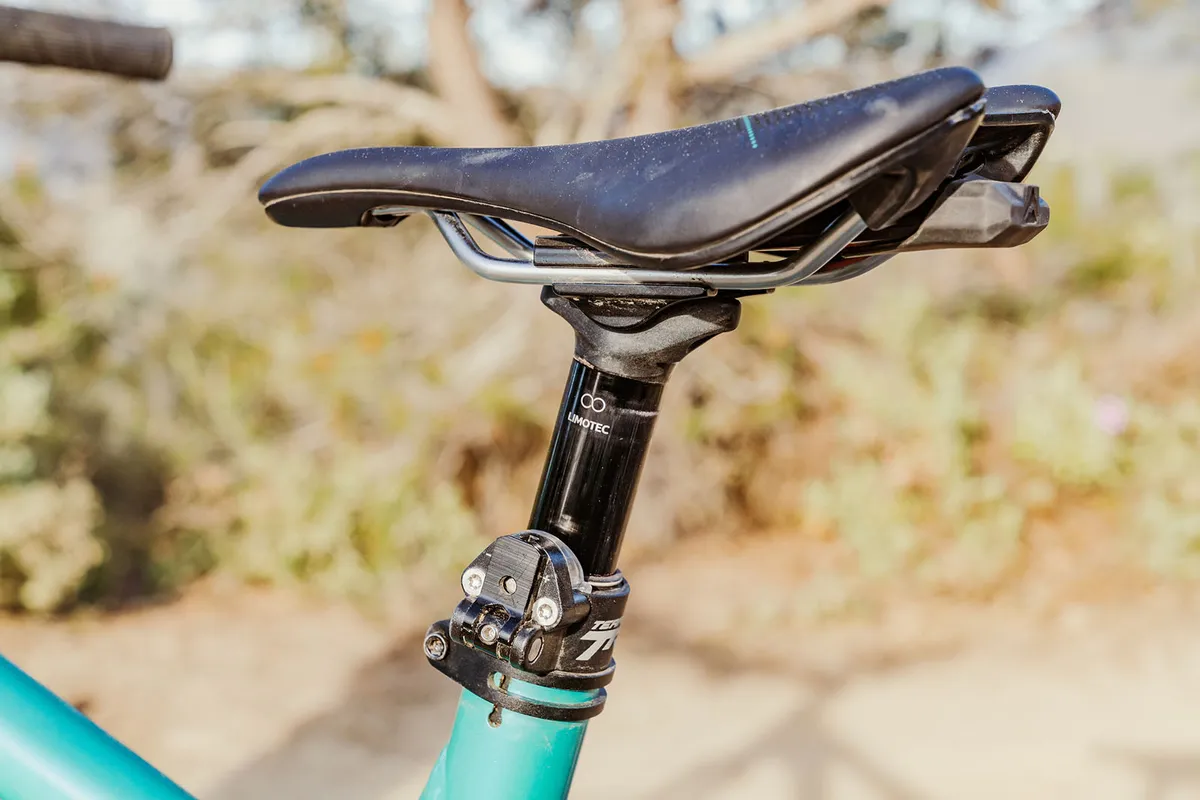
Traction is still good, though understandably with little give in the system, you’re more reliant on the tyres to generate what they can, rather than it being bolstered artificially by the suspension helping everything mould to the ground’s contours.
Up and over steps, there’s a bit of a lurch as you crest the rock or root edge and the suspension stays static, but not in a way that disrupts pedalling rhythms.
Where grip or directional control becomes tricky, the ample room over the top of the bike means you’re able to easily shift body weight to best add grip, or control the front wheel’s path.
The Dissector’s tread feels as though it gives a good blend of grip (up and downhill) and rolling resistance, so the One-Forty doesn’t feel too sluggish on tarmac drags.
I liked the Shimano SLX hub’s snappy-feeling engagement on technical climbs. Being able to ‘ratchet’ through tech sections helps keep the flow going.
Merida One-Forty 700 descending performance

On descents, the One-Forty impresses.
There’s no doubt that long reaches, moderately slack head angles, decent rubber and a plush, burly fork up-front is a great basis for descending performance.
You can set the Merida up to be a point-and-shoot kind of bike, spying the exit of a section and letting the suspension and tyres do the rest. However, choose to pick a line, hop over a root and slither through some S-bends, and the One-Forty is more than adept at massaging your ego and being guided through your chosen line.
If you’re more into ‘pick a line’ riding, then sizing down might be an idea. While I was happy moving and shaking on my size-Long, at 182cm tall, there’s no doubt the Mid would have been a more agile ride.
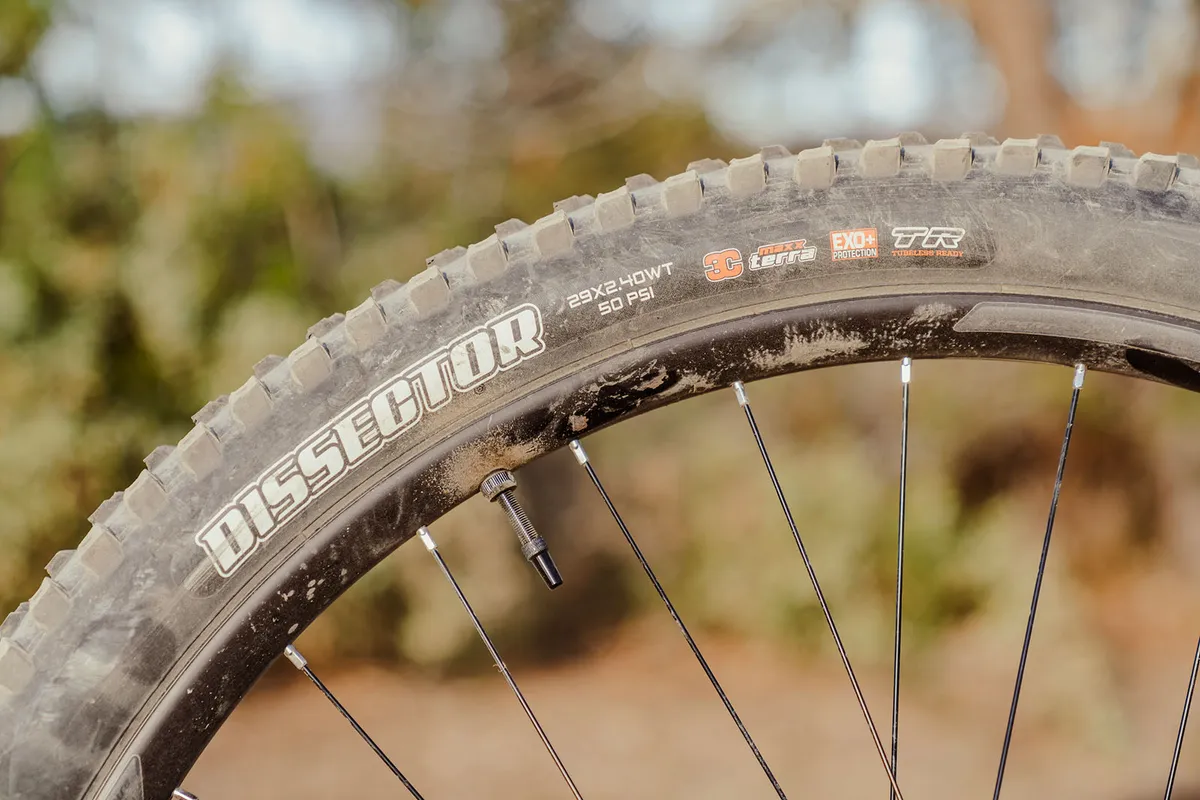
It would perhaps be a touch easier to pick up and place, needing less exaggerated body weight shifts to get the bike moving how I wanted.
At the same time, the length of my Long bike meant I rarely felt threatened by steep, loose, fast rocky tracks.
Dropping the bike into a long, flat corner highlights how good this new approach to geometry is at providing consistent grip and control, as it cuts a calm path round bends.
If there’s one criticism of the geometry, it’s that the steep seat angle puts more weight through your wrists on flatter sections of trail, or when rolling along the road.

The rear suspension’s support, that helps propel it uphill, gives you a platform to push against, so speed can be generated through berms and lips can be sent as far as you dare.
If you need to take a few mid-trail pedal strokes, the bike doesn’t sink deep into its travel, instead staying propped up in its mid-stroke, where the suspension works at ironing out the bumps.
This stability means it’s not quite as smooth over chatter as the Vitus Escarpe, or Marin Rift Zone XR that I also tested, but given the shape of the bike and the rubber wrapped around the rims, you’re unlikely to come unstuck. The suspension definitely does its job of keeping the wheels connected to the ground.
At 80kg suited up, I felt the rear suspension was just about right in terms of tune, however lighter riders might find a lighter shock tune would give a slightly more refined, supple ride.
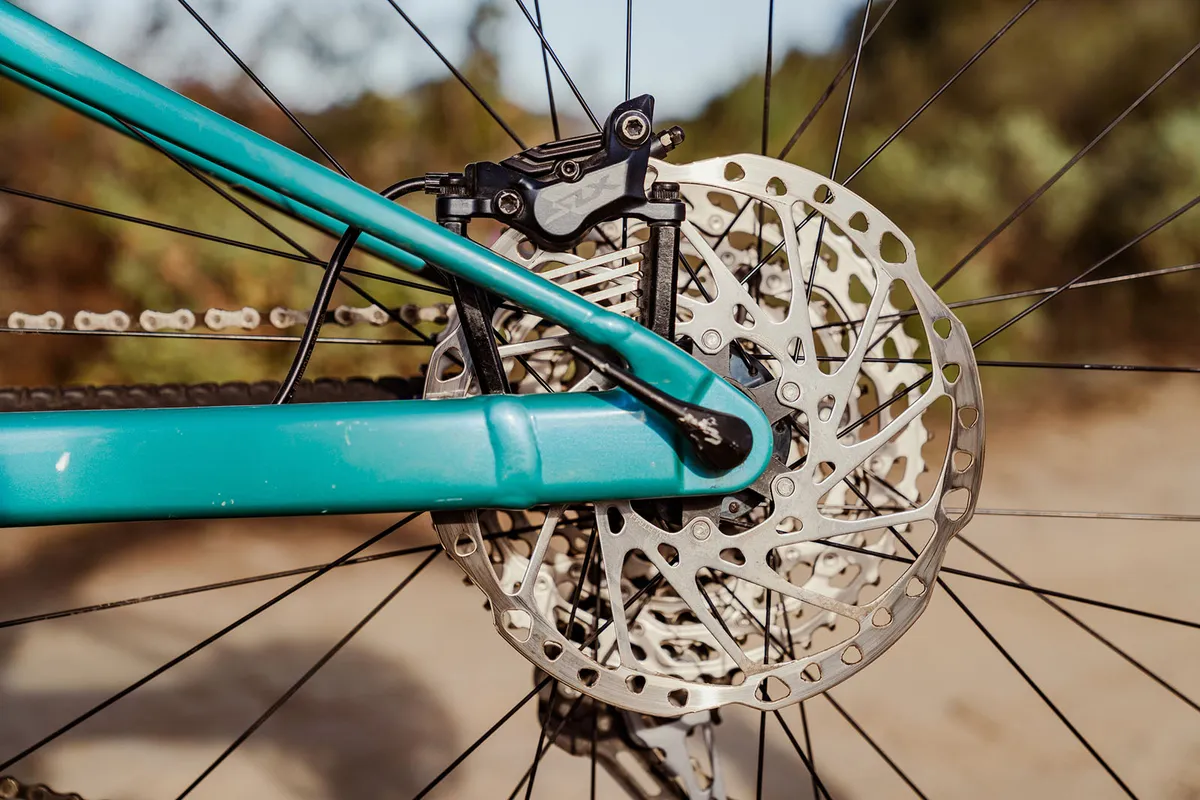
Find yourself on the edge of a steep chute, and you’re in safe hands. The front wheel is far ahead of your weight, so it feels as if you can drop into anything, and the 203mm rotors at both ends are squeezed by the powerful, punchy Shimano SLX 4-piston calipers.
The Minion DHF, mounted to the wide rim, does sterling service at the front of the bike.
An SLX drivetrain, with upgraded XT shifter, makes short work of shifting duties, while the Race Face Aeffect crank add a little Canadian sparkle.
Marzocchi’s Z1 fork is, in my opinion, one of the best suspension forks on bikes at this price point. It’s easy to set up, and simply works well.
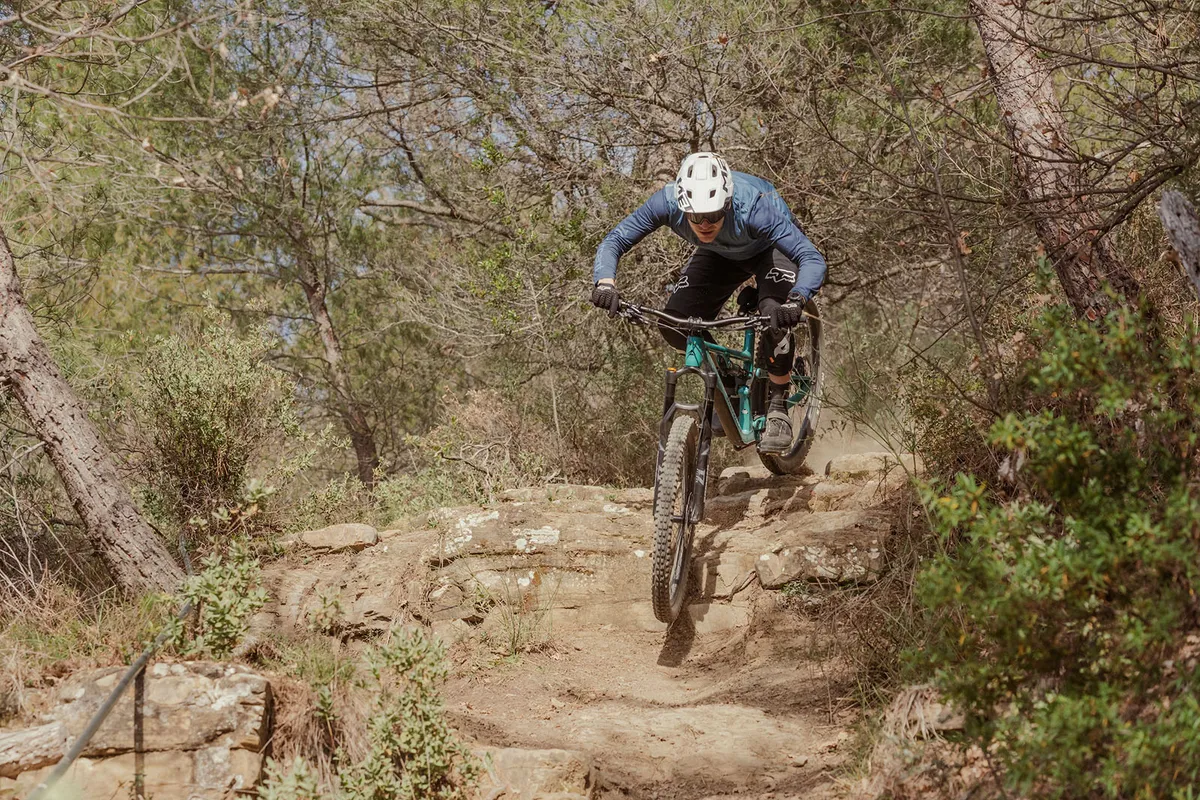
Its action is smooth, the spring supportive enough for most riders, and there’s a lockout on top if you need it.
The chassis is stout, too, resisting binding, and giving an authoritative feel to the front of the bike.
The grips weren’t quite to my taste, and I soon swapped the 50mm stem to a 40mm version, enhancing an already impressive handling package. Shortening the stem just helps ensure this long 29er retains sharp handling in tighter, twistier situations.
How does the Merida One-Forty 700 compare to the Cotic Jeht?

Both the Merida One-Forty and the Cotic Jeht are 140/150mm-travel, relatively burly trail bikes with the option to run mullet wheels.
The Merida outshines the Cotic on climbs, with impressive efficiency through the pedals. However, if traction is at a premium, the Cotic will just about scrabble to the top ahead of the Taiwanese bike.
When it comes to the descents, both bikes are ‘big’, but they feel different. The Cotic’s Cane Creek BD Inline has a lovely, smooth fluidity to its feeling, while the Merida is more direct and efficient.
They both thrive on the steepest tracks, but I’d pick the Merida for a long day in the hills, thanks to its efficiency.
Merida One-Forty 700 bottom line
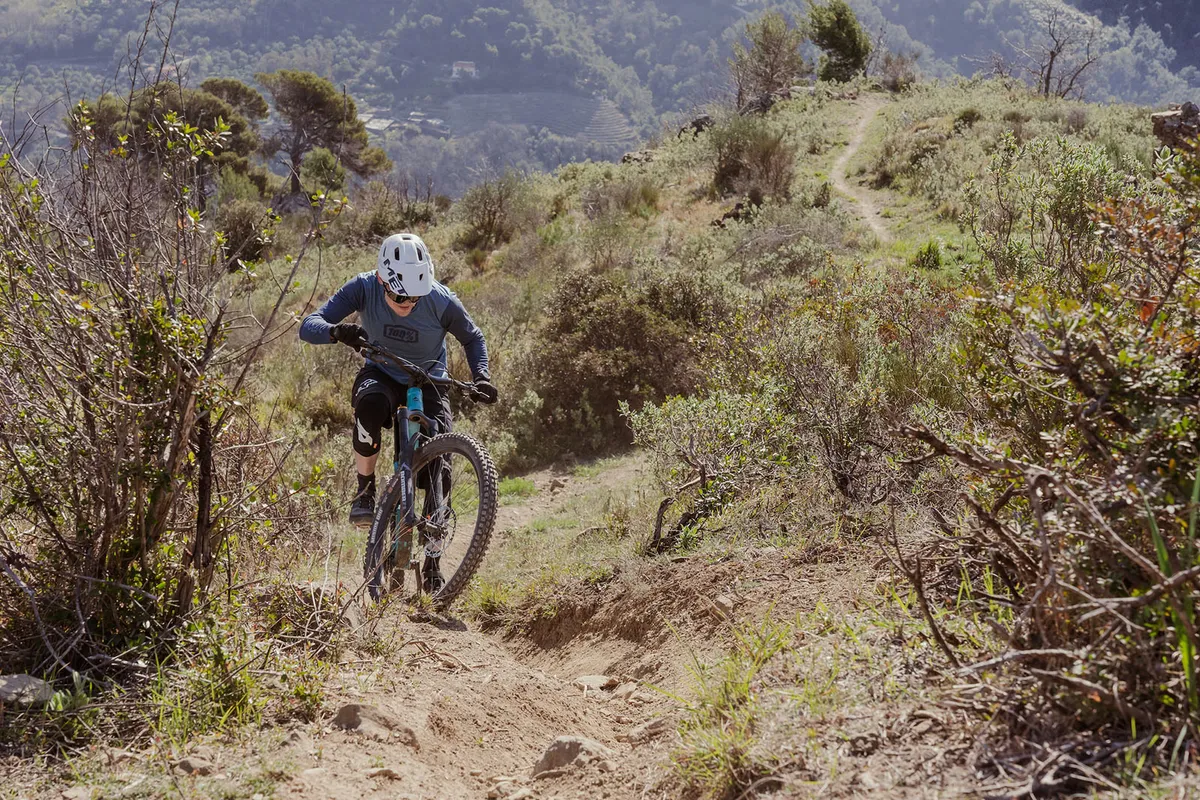
The Merida One-Forty 700 ticks a lot of trail-bike shaped boxes. If climbing is a chore, the lack of wallow will make it easier, while if it’s something you enjoy, you’ll likely love its perky attitude.
On the way down, the geometry is spot on, offering confidence, composure and accurate handling. The range of sizes that’ll fit most riders is impressive too, so you’re not pigeon-holed into a single bike size. You can size down for agility, or size up for stability – the adjustable dropper, low stack and short seat tube give you options.
Add in excellent parts and a competitive price, and for a broad range of trail riding applications, it’s hard to look much further than the One-Forty in 2023.
Trail Bike of the Year 2023 | How we tested
This bike was ridden as part of our 2023 Bike of the Year test. It was compared to seven of the best trail bikes.
I took all the bikes to the same locations and trails for some dedicated back-to-back testing on a wide variety of terrain.
From hand-dug cheeky tracks in the woods to trail centre laps and Bike Park Wales’ rocky runs, I ensured the bikes were exposed to every type of trail such a bike is likely to be ridden on.
Riding the bikes back to back, usually with four bikes in each testing session, ensured I was able to pick out the finer performance points of each one.
Our Trail Bike of the Year contenders
- Cannondale Habit Carbon 3
- Cotic Jeht Mullet Silver SLX
- Marin Rift Zone 27.5 XR
- Merida One-Forty 700
- Trek Fuel EX 8 Gen 6
- Vitus Escarpe 29 CRS
- Whyte T-140 RS 29
- YT Jeffsy Core 3
Thanks to…
Thanks to our sponsors Crankbrothers, FACOM Tools, MET helmets, Bluegrass Protection, Supernatural Dolceacqua, Le Shuttle and BikePark Wales for their support in making Bike of the Year happen.
Product
| Brand | merida |
| Price | 3869.00 EUR,3100.00 GBP |
| Weight | 16.1000, KILOGRAM (Long) - without pedals |
Features
| Fork | Marzocchi Z1, 150mm travel |
| br_stem | Merida Expert eTRII, 50mm |
| br_chain | KMC X12 |
| br_frame | Aluminium, 150/143mm travel |
| Tyres | Maxxis Minion DHF 3C Maxx Terra EXO TR WT 29x2.5in f, Maxxis Dissector EXO+ TR 29x2.4in r |
| br_brakes | Shimano SLX M7120, 203/203mm rotors |
| br_cranks | Race Face Aeffect, 32t |
| br_saddle | Merida Expert SL |
| br_wheels | Merida Expert TR rims on Shimano SLX hubs |
| br_headset | Merida 8158 |
| br_shifter | Shimano XT |
| br_cassette | Shimano Deore 10-51 |
| br_seatpost | Merida Team TR |
| br_gripsTape | Merida Expert EC |
| br_handlebar | Merida Team TR, 780mm |
| br_rearShock | RockShox Deluxe Select+ |
| br_bottomBracket | Race Face |
| br_availableSizes | X Short, Short, Mid, Long, X Long |
| br_rearDerailleur | Shimano SLX |
